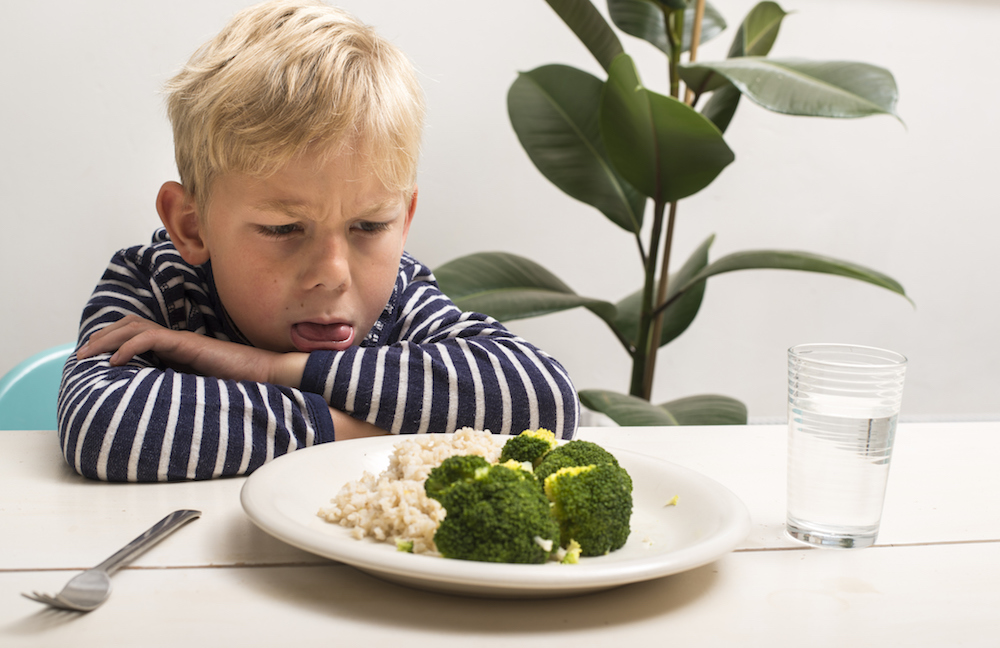Topics

Image Source
Let’s be honest – raising toddlers is challenging. These stages aren’t nicknamed “terrible 2s” or “three-nager” for nothing. In reality, most toddlers know what they want and how they want it, and they wanted it two minutes ago. Their favorite word is “no,” and they can be nearly impossible to reason with. The frequent tantrums, potty training challenges, headbanging, screaming, hitting and biting make the newborn period seem like a fond memory when compared to living with a toddler. Therefore, it’s no surprise to me when parents raise concerns about their toddler’s picky eating.
A toddler’s food preferences can be unpredictable. Suddenly, your delightful and happy baby who used to eat all kinds of baby food has now morphed into mac and cheese-loving, carb-craving, vegetable-hating, opinionated food dictator. Sound familiar? You’re not alone. It’s common for toddlers to switch up their eating habits, so don’t be shocked if your toddler refuses a particular food one day and accepts it the next. Remember, toddlers don’t grow as quickly as they did in their first year, so they will face fluctuation in their appetites. Portion requirements also slow down considerably at this age.
Ready for some good news? This is the best time to teach and enforce good eating habits. It will take a lot of time, and even more patience. If you set good eating habits now, they will carry on into the rest of your child’s life. We face many battles when raising toddlers, but proper and healthy eating is one parents should strive to win in the long run. Our toddlers might know what they want, but they don’t know what they need.
If you’re trying to get your toddler to accept particular foods, form good eating habits and avoid carrying picky eating into adolescence, consider the below tips.
Serve meals regularly and limit grazing or excessive snacking throughout the day. Meals should be served at the table with other family members, promoting routine and predictability.
Don’t let toddlers drink their calories. The American Academy of Pediatrics (AAP) recommends approximately 2.5 servings of dairy per day if your toddler can drink milk, and also discourages juice and soda consumption due to their lack of nutritional value and relationship with childhood obesity.
Offer new foods alongside familiar food your toddler favors. Promoting food diversity and introducing new foods can open up a range of options for your picky eater.
Let toddlers explore their foods, even if they make a mess from time to time. Encourage playing, touching, smelling, licking and even taking small bites. If your child decides to take a bite or two, give praise.
Don’t bribe your child to eat healthy food using unhealthy food. The goal is to get your child to enjoy and crave healthy foods instead of simply tolerating them.
Their meals should be well balanced, offering plenty of fruits and vegetables. You decide what your toddler eats, but let them decide how much they want to eat. Your pediatrician will review growth charts during check-ups to ensure your toddler is getting the right amount of calories.
Set a good example by eating a nutritious, diverse diet. You are your toddler’s most important influence. Make it a family effort, too!
Don’t stock junk food in your home. If this isn’t an option, make sure this food is hard to access for your toddler.
Discuss the benefits of healthy, nutritious eating. Bring your toddler to go grocery shopping with you and encourage participation in food preparation. Talk about making healthy choices and eating fresh food instead of processed snacks.
Use toddler-sized portions. A serving size for a toddler is about ¼ of a single adult portion. It’s normal for your toddler to take a few bites and feel full. Remember that sitting at a table for 10 minutes is a very long time for a toddler, so set a timer for five minutes and slowly extend time at the table up to 15 minutes.
Minimize distractions at the table while eating. No screens! There are many negative effects that can come from eating while watching television, including connections to obesity and poor academic performance.
In summary, it’s quite normal for toddlers to shy away from certain foods. Despite negative initial reactions, your child will likely learn to accept the food with time and repeated exposure. Getting a toddler to eat a balanced diet is a long process requiring patience and perseverance. When your children mature into healthy adults, they will learn to appreciate your efforts.

